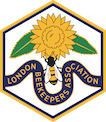
|
London Beekeepers' Association |

|
London Beekeepers' Association |
June in the Apiary[In the apiary, month by month.] Howard Nichols Swarm controlThis is still the main priority if the colony has not yet swarmed. Swarming has been sluggish this year and many colonies have not swarmed. Routine inspections should be made every 7 days to check for queen cells. Make sure you have sufficient spare equipment for swarm control. Upon finding open queen cells, you have sufficient time to close up the colony, go home to think things through and collate equipment. You are unlikely to have time to order equipment from a supplier, have it delivered and make it up. For anyone with access to Ted Hooper’s excellent Guide to Bees and Honey then Artificial Swarm method is covered extremely well on pages 138 to 140. The National Bee Unit also has helpful helpsheet. Removing honeyAnother seasonal task in early June is removing and processing the spring honey brought in by the bees. This year we have had a cold spring and I am not aware of our own members reporting spring honey. Personally, I do not remove spring honey but leave it until July when I remove it with the summer honey. If spring honey is removed then keep a watch on stores within the hive.Collecting swarmsIf your bees do swarm or you are called out to collect another swarm then personal and public safety should always be the overriding priority. Do not attempt to climb trees or use ladders beyond your capabilities. A simple order of action may be as follows:
Other action to be taken this monthAdd supers. Add supers as necessary, adding another in advance of it being needed by the bees. This may be either a brood super or a honey super, depending upon circumstances. Check varroa mite drop. Check varroa mite drop if not done in April or May. The Beebase varroa calculator is a useful diagnostic tool. Carry out a specific brood disease inspection. The essence of this is to know what is normal and healthy and so to look out for anything that deviates from this. It is good to do this with a beekeeping friend as you may be looking for only 1 or 2 infected cells in the whole colony. Have spare frames. Ensure you have sufficient frames to deal with the honey flow when it arrives. In London it often commences in late June when more rural areas are experiencing a June gap. It is a lot easier to simply add a super than having to extract a super and put it back in the middle of the honey flow. This may not even be possible as the water content may still be too high for extraction. Enjoy your June beekeeping activities. It is a short season and June is a busy part of the season. |
©2025 London Beekeepers' Association |